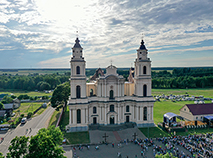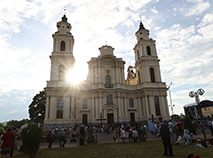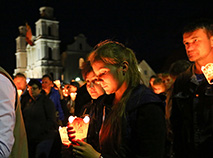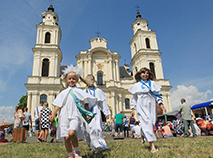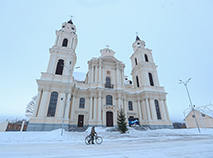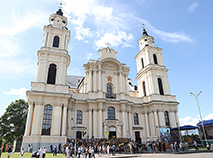Budslau Fest
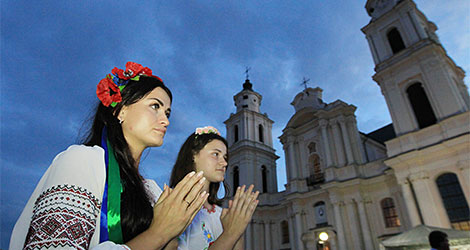
For more than four centuries pilgrims from various cities and countries have come to the town of Budslau to bow to the wonder-working Budslau Icon of Our Lady. The annual fest has grown into a beautiful spiritual celebration which brings together thousands of pilgrims.
In November 2018, the UNESCO Intergovernmental Committee for the Safeguarding of the Intangible Cultural Heritage announced the decision to inscribe Budslau Fest on the UNESCO Representative List of the Intangible Cultural Heritage of Humanity.
Wonder-working Budslau Icon of Our Lady
 The 16th century icon of unknown origins had come a long way before it made it to the Budslau monastery church to become a true national treasure of Belarus.
The 16th century icon of unknown origins had come a long way before it made it to the Budslau monastery church to become a true national treasure of Belarus.
Its first owner was Minsk governor Jan Pac who got it from Pope Clement VIII during the pilgrimage to Vatican in 1598. He kept the relic in his palace and worshiped it his whole life.
After the death of Jan Pac, the icon was taken by chaplain Isaac Salakai who brought it to the town of Dolginovo near Budslau. In 1613, Isaac Salakai came for a Good Friday service to the Budslau Bernardine church (at that time still wooden) where monks persuaded him to gift the icon to the church.
The canvas 72x65cm large depicts Mother of God with Infant Jesus in oil. The icon was made in the West European style of Hodegetria – the Lady of the Way. Virgin Mary holds Jesus with her left hand and looks at the viewer. Infant Jesus holds out his hands to the Mother: with the left he seems to offer a pomegranate (Biblical symbol of resurrection) and with the right gives a blessing. Mother of God wears a crown with gem stones. The icon is covered with a gilded silver riza and adorned with a silver frame bearing a Late Renaissance ornament. The riza and the frame were gifted to the icon in the first half of the 17th century.
The Budslau sanctity was relocated to the high altar in 1635. By 1643 under the guidance of Polotsk architect Andrei Kromer, the Budslau church was rebuilt using stone. Craftsman Piotr Gramel made a unique wooden altar in which the icon was put.
In 1650 the senior priest of the church Elevtery Zeleyevich described the miracles attributed to the Budslau icon in his book Zodiac on the Earth. In his words, records documenting the miracles were fastened to the walls of the then wooden church. The first miracle was documented back in 1617: the icon was believed to help restore the sight of a 5-year old blind boy Iosafat Tyshkevich. After the boy recovered from a severe disease, he devoted himself to God in return for his cure and years later he became a famous priest. Elevtery Zeleyevich documented 42 stories of recovery. The icon helped “… the feeble, the lame, epileptics, the dumb, those injured by the lightning and other calamities”.
The construction of a new stone Catholic church was launched in Budslau in July 1767. This grandiose basilica was meant to glorify the Assumption of Our Lady. The first stone church became its side chapel and was named after Saint Barbara. This magnificent Late Baroque church still impresses parishioners and pilgrims. It is one of the three catholic churches in Belarus bearing the title of a minor basilica.
During their retreat in 1941, the Red Army planned to demolish the church. However, the local gathered at the temple on the eve of the planned demolition and spent the night in prayers addressing the wonder-working icon. In the morning the army left Budslau, while the church remained intact.
The Budslau Icon of Our Lady has become a national treasure for Belarusians. Moreover, not only Catholic believers consider it as a sacred relic: people of all Christian denominations visit Budslau in the multi-faith country of Belarus.
The legendary icon was crowned on 2 July 1998. Cardinal Kazimierz Swiatek attached papal crowns to the icon. The action gave a new status to the Budslau Church of the Assumption of Our Lady. The church became a national sanctuary where relics of the country’s patroness are kept.
Believers also consider it a wonder that after 400 years the paint on the icon has not been tarnished. The flow of pilgrims willing to see it rises every year.
Budslau Fest – a celebration in honor of the Icon of Our Lady
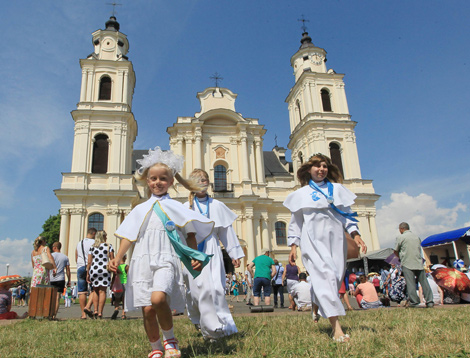 The tradition to make a pilgrimage to Budslau is now many generations old: pilgrims have been coming to worship the icon since the 17th century. Even when the church had no priest, people would gather there, invite pilgrims, and share bread and roof with the guests.
The tradition to make a pilgrimage to Budslau is now many generations old: pilgrims have been coming to worship the icon since the 17th century. Even when the church had no priest, people would gather there, invite pilgrims, and share bread and roof with the guests.
In contemporary Belarus large organized pilgrimages to see the Icon of Our Lady have been in place since 1992. Pilgrims from all parts of the country, from the neighboring countries of Russia, Poland, Lithuania, and non-CIS countries come to Budslau. In order to bow to the relic, people travel dozens and even hundreds of kilometers and participate in communal prayers. Many say that the difficult journey helps them clear themselves, get answers to their questions and find solace, understand something important.
Pilgrims live in makeshift camps set up on the road. Following the kind tradition, residents of nearby villages welcome pilgrims and offer bed and dinner. Once in Budslau when they have only several meters to reach the icon, the pilgrims kneel down and travel the remaining distance in this manner.
Alongside with traditional pilgrimages, there are fasting (bread and water) pilgrimages for people addicted to drugs and alcohol (they include both prayers and special conversations).
A bike-pilgrimage to Budslau has become popular as well. Cycling pilgrims set off from the famous Red Church in Minsk to Budslau several days ahead of the celebrations. They are joined by Metropolitan of Minsk and Mogilev, Archbishop Tadeusz Kondrusiewicz.
The Budslau Icon of Our Lady is honored on 2 July, the major day of Budslau Fest celebrations. The evening service and night procession are the most impressive parts of the festival. Thousands of believers light up candles and walk together with the Icon bearer to the center of Budslau and back to the church. It all looks as if a huge fire river is floating in front of the magnificent basilica.
The summer catholic fest to celebrate the Budslau Icon of Our Lady has become the nation’s heritage.
In 2013 Budslau celebrated 400 years of the acquisition of the Icon of Our Lady. Thousands of Catholic pilgrims gathered to mark the event. Among the invitees were Orthodox believers, Protestants, Muslims, Jews, government officials and diplomats.
In 2014 Budslau Fest was included into the State List of Historical and Cultural Heritage of Belarus. Residents of Budslau gave their written consent to this.
For several years up to November 2018 Belarus worked hard to have Budslau Fest inscribed in the UNESCO Representative List of the Intangible Cultural Heritage of Humanity.







 print version
print version make home page
make home page add to bookmarks
add to bookmarks